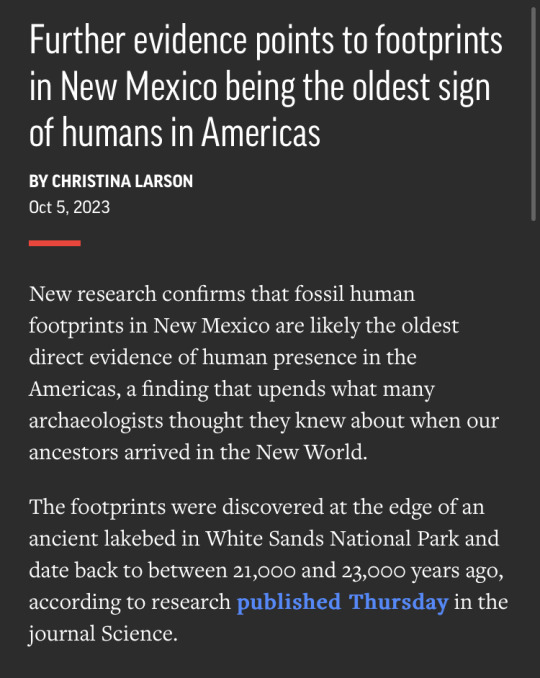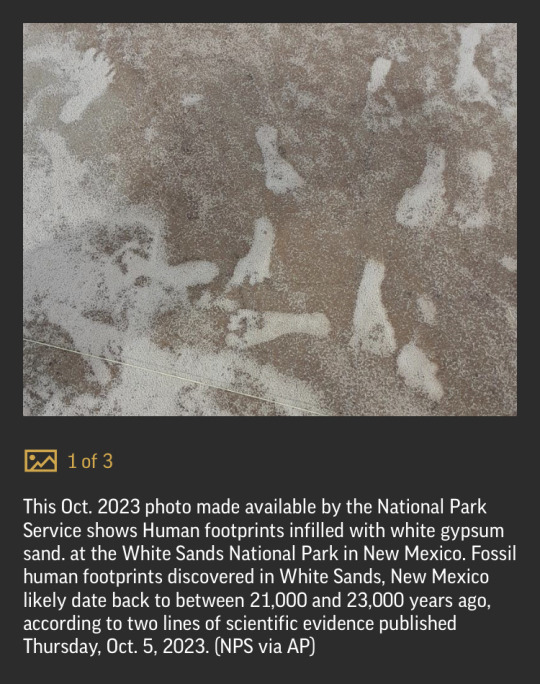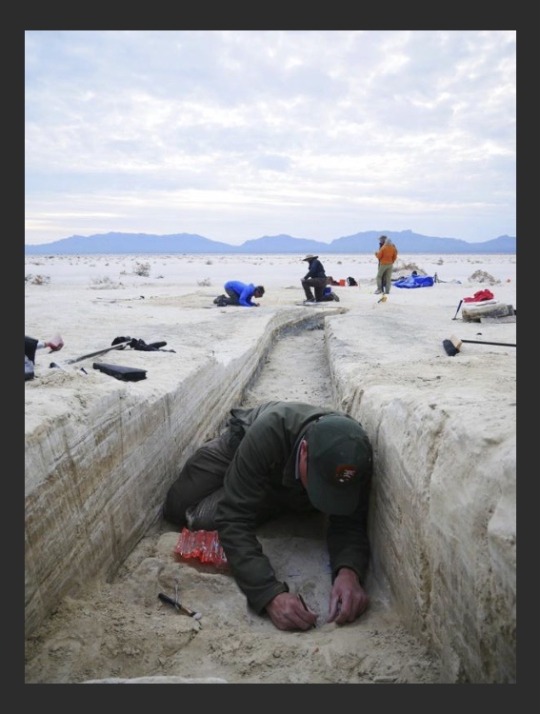#New Mexico Footprints are Oldest Sign of Humans in Americas
Text

New Mexico Footprints are Oldest Sign of Humans in Americas
Fossil footprints date back to between 21,000 and 23,000 years ago, upending previous theory that humans reached continent later.
New research confirms that fossil human footprints in New Mexico are probably the oldest direct evidence of human presence in the Americas, a finding that upends what many archaeologists thought they knew.
The footprints were discovered at the edge of an ancient lakebed in White Sands national park and date back to between 21,000 and 23,000 years ago, according to research published on Thursday in the journal Science.
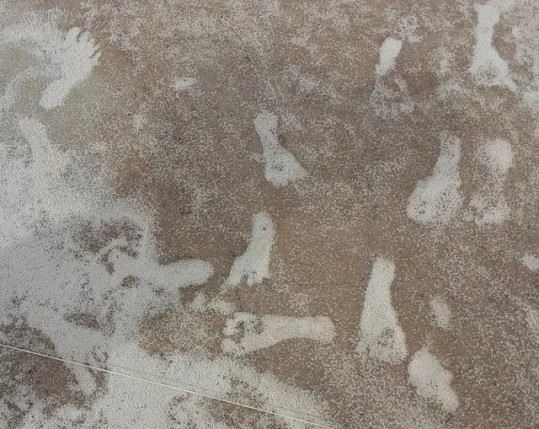
The estimated age of the footprints was first reported in Science in 2021, but some researchers raised concerns about the dates. Questions focused on whether seeds of aquatic plants used for the original dating may have absorbed ancient carbon from the lake – which could, in theory, throw off radiocarbon dating by thousands of years.
The new study presents two additional lines of evidence for the older date range. It uses two entirely different materials found at the site, ancient conifer pollen and quartz grains.
The reported age of the footprints challenges the once conventional wisdom that humans did not reach the Americas until a few thousand years before rising sea levels covered the Bering land bridge between Russia and Alaska, perhaps about 15,000 years ago.
“This is a subject that’s always been controversial because it’s so significant – it’s about how we understand the last chapter of the peopling of the world,” said Thomas Urban, an archaeological scientist at Cornell University, who was involved in the 2021 study but not the new one.
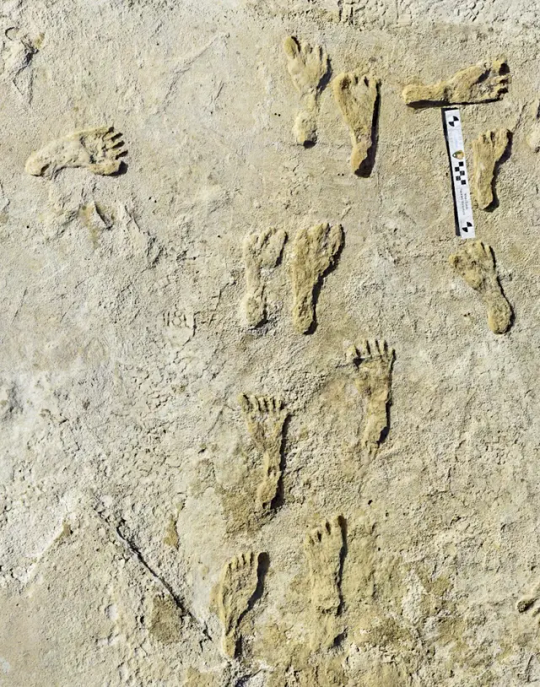

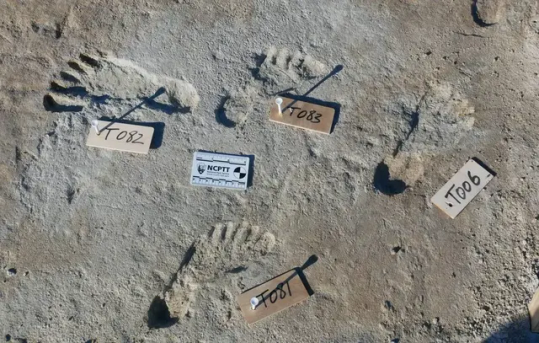
Thomas Stafford, an independent archaeological geologist in Albuquerque, New Mexico, who was not involved in the study, said he “was a bit skeptical before” but now is convinced.
The new study isolated about 75,000 grains of pure pollen from the same sedimentary layer that contained the footprints.
“Dating pollen is arduous and nail-biting,” said Kathleen Springer, a research geologist at the US Geological Survey and a co-author of the new paper.
Ancient footprints of any kind can provide archaeologists with a snapshot of a moment in time. While other archeological sites in the Americas point to similar date ranges – including pendants carved from giant ground sloth remains in Brazil – scientists still question whether such materials really indicate human presence.
“White Sands is unique because there’s no question these footprints were left by people, it’s not ambiguous,” said Jennifer Raff, an anthropological geneticist at the University of Kansas, who was not involved in the study.

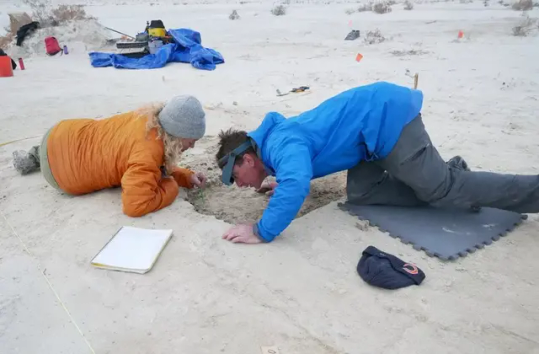
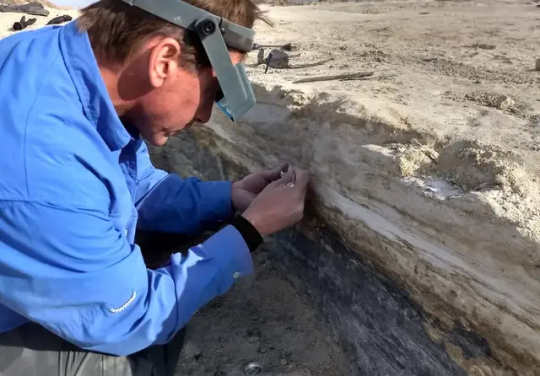

#New Mexico Footprints are Oldest Sign of Humans in Americas#fossil#fossil footprints#White Sands national park#ancient artifacts#geology#geologist#archeology#archeolgst#history#history news#ancient history#ancient culture#ancient civilizations#ancient man
656 notes
·
View notes
Text
White sands national park
Footprints may be earliest example of humans in North America
https://www.theguardian.com/science/2023/oct/06/footprints-humans-americas-oldest-sign-new-mexico
View On WordPress
0 notes
Link
0 notes
Text
Further evidence points to footprints in New Mexico being the oldest sign of humans in Americas
Christina Larson for the AP:
New research confirms that fossil human footprints in New Mexico are likely the oldest direct evidence of human presence in the Americas, a finding that upends what many archaeologists thought they knew about when our ancestors arrived in the New World.
The footprints were discovered at the edge of an ancient lakebed in White Sands National Park and date back to between 21,000 and 23,000 years ago, according to research published Thursday in the journal Science.
The estimated age of the footprints was first reported in Science in 2021, but some researchers raised concerns about the dates. Questions focused on whether seeds of aquatic plants used for the original dating may have absorbed ancient carbon from the lake — which could, in theory, throw off radiocarbon dating by thousands of years.
The new study presents two additional lines of evidence for the older date range. It uses two entirely different materials found at the site, ancient conifer pollen and quartz grains.
I did post about this two years ago when the research was first announced, we love it when multiple approaches return the same result
0 notes
Link
Further evidence points to footprints in New Mexico being the oldest sign of humans in Americas – The Lifestyle Insider
0 notes
Link
Fossil footprints date back to between 21,000 and 23,000 years ago, upending previous theory that humans reached continent laterNew research confirms that fossil human footprints in New Mexico are probably the oldest direct evidence of human presence in the...
0 notes
Text
Further evidence points to footprints in New Mexico being the oldest sign of humans in Americas - ABC News
1 note
·
View note
Text
What's the earliest evidence of humans in the Americas?

A nomadic group in Mongolia moves camp with their camels and other animals. At least 16,000 years ago during the last ice age, nomadic humans traveled across the Bering Land Bridge from Asia to North America. (Image credit: Tuul & Bruno Morandi via Getty Images)
The arrival and establishment of humans in the Americas was a key step in humanity's trek across the planet, but exactly when this milestone was achieved remains hotly contested. According to the evidence we have now, when did the first humans arrive in North America?
Based on stone artifacts dating to about 13,000 years ago, archaeologists for most of the 20th century suggested that the prehistoric Clovis culture was the first to migrate to the Americas. However, the site of Monte Verde in southern Chile, first discovered in 1975, was found to be about 14,200 years old. If people made it that far down in South America by that point — either after their ancestors crossed over the Bering Land Bridge that once connected Asia and North America, or traveling in watercraft along Pacific coasts — then earlier sites must exist in North America, Michael Waters, a geoarchaeologist at Texas A&M University, told Live Science.
Starting in 2009, archaeologists began excavating deposits at the Cooper's Ferry site in Idaho. Radiocarbon dating of human projectile points in these deposits revealed that people found their way inland into North America by about 16,000 years ago, Waters noted. Cooper's Ferry may be the oldest strong evidence of human settlement of the continent yet, and unpublished research from 2023 describes slightly older evidence; stone tools next to animal teeth dated to 18,000 years ago in Oregon. However, scientists recently found controversial signs of even older sites in North America.
In 2020, archaeologists digging in Chiquihuite Cave in the Astillero Mountains of central Mexico unearthed about 1,900 stone artifacts. Radiocarbon and optically stimulated luminescence dating of the objects suggested that humans might have occupied the area 31,000 to 33,000 years ago.
Later, in 2021, scientists tested 60 human footprints embedded in an ancient lake bed in what is now White Sands National Park in south central New Mexico. By using carbon-dating methods on seeds found in sediments within the prints, they suggested that people occupied the New World between about 21,000 and 23,000 years ago.
However, there are problems with the claims made at both the Chiquihuite and White Sands sites, Matthew Des Lauriers, an archaeologist at California State University, San Bernardino, told Live Science.
When it comes to Chiquihuite, even the scientists who excavated the site noted that others might argue that the oldest stone objects discovered there are not of human origin but are merely "geofacts," or normal rocks that look artificial. A 2021 study from an independent group indeed made that argument.
As for White Sands, the footprints are clearly human, Waters noted. But he noted that ancient plant samples used to date the footprints may seem older than their true age.
"The footprints have real problems with the dating," Des Lauriers said. Waters estimated the prints may actually be only about 15,000 years old.
A number of claims based on stone artifacts discovered in Brazil suggested that humans may have reached sites there, such as Pedra Furada, about 35,000 years ago, Waters noted. However, a 2022 study revealed that these artifacts may actually have been created by capuchin monkeys as they used rocks to break open nuts, he added.
RELATED MYSTERIES
—What is the oldest-known archaeological site in the world?
—What was the longest-lasting civilization?
—How did ancient people store food before refrigeration?
But other evidence is emerging of early human occupation in South America. A 2023 study found 27,000-year-old sloth bones crafted by humans into pendants from Brazil.
New ideas often come and go about the people of the Americas. For instance, "a few years back, it was suggested that people came from western Europe to the Americas, the 'Solutrean hypothesis,'" Waters said. However, "recent genetic work on Solutrean human remains shows that they are not at all related in any way to the Indigenous peoples of the Americas. Thus, this hypothesis can be discarded."
All in all, "the public needs to know that archaeology is a process," Waters said. "Science follows a course — publication of new data, vetting of that data, more testing, and acceptance or rejection of ideas. This is a slow and careful process."
Read the full article
0 notes
Link
Chaco Canyon is a land of extremes. Summer heat scorches the desert canyon, which is sandwiched between sandstone cliffs nearly two kilometers above sea level in New Mexico’s northwestern corner. Bitter cold sweeps in for winter. Temperatures can swing as many as 28 degrees Celsius during the course of a day. Through it all, Chaco Canyon maintains a desolate beauty and a craggy pride as home to one of ancient America’s most enigmatic civilizations.
Scientists have struggled to understand Chaco society since its first excavations in the late 1800s. Who first settled Chaco Canyon around 1,200 years ago is still a mystery. Many researchers suspect that it took a few hundred years for a fledgling city-state run by an elite social class to emerge. Political and cultural ties between the ancient society and Chaco-style communities outside the canyon also perplex. Then there’s the puzzle of how people survived from about 800 to around 1300 on the rough, parched terrain.
A new generation of Chaco studies and discoveries is under way, partly thanks to a young researcher’s skeleton reassembly project. This jigsaw job required a lot of travel, but not to Chaco Canyon.
That’s because bones of people excavated at Chaco in the 1890s and 1920s were packed away in boxes and drawers at museums in New York City, Chicago and Washington, D.C. Kerriann Marden visited all of these places to retrieve far-flung body parts from one site in particular — Pueblo Bonito, the oldest and largest of a dozen huge stone great houses in Chaco Canyon. The structure was built, along with a range of smaller structures, between about 800 and 1130.
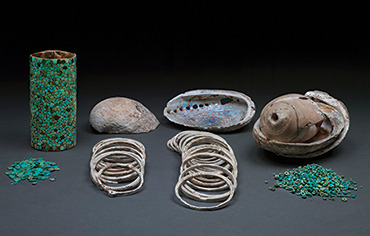
Finds in a burial at the first and largest great house in Chaco Canyon, Pueblo Bonito, include turquoise jewelry and shell items placed alongside a presumably influential man interred between 800 and 850.
Pueblo Bonito was massive, rising at least five stories with around 650 rooms. It has yielded more human bones and artifacts than any other Chaco site. Research has focused on this great house presumably reserved for Chaco’s elite families; the lives of workaday folk have been largely unexplored, even in the latest studies.
During Chaco society’s heyday, other civilizations peaked elsewhere in the Americas, including the Maya in Central America. Just as present-day Maya groups trace their ancestry back to that ancient civilization, today’s Pueblo tribes, such as the Hopi and Zuni, consider Chaco people to have been their forebears. Navajo Nation also claims an ancestral tie to Chaco society.
Reassembly required
Archaeological excavations a century or more ago — at Pueblo Bonito and elsewhere — didn’t follow today’s rigorous standards for excavating and preserving remains. The work consisted of little more than mining for bones and artifacts, then carting the discoveries off to museums. As an anthropology graduate student at Tulane University in New Orleans, Marden journeyed back and forth between New York’s American Museum of Natural History, Chicago’s Field Museum and Washington’s Smithsonian National Museum of Natural History from 2005 to 2011. She painstakingly reunited long-dead Chaco individuals’ skulls with arms, legs with feet and so on. Marden is now a forensic anthropologist at Eastern New Mexico University in Portales.
As skeletons assumed their former shapes, a couple of peculiar things stood out. First, many individuals bore signs of disease, including tuberculosis and syphilis. That seemed peculiar for people who were buried in a great house typically thought to have been reserved primarily for society’s upper crust, not for the ill. Second, bodies had been manipulated in unusual ways and for unknown reasons. Comparisons of restored skeletons with field notes and photographs from original excavations indicated, for instance, that one woman was originally found with a fetus’s fragile remains in her pelvic cavity and her own bones below the knees missing. Her body lay across a room from several intact bodies.
“Nothing is simple at Pueblo Bonito,” Marden says. Her campaign to put Pueblo Bonito skeletons back together has enabled a couple of provocative new investigations. One concludes that members of a single maternal line wielded power in Chaco society from the start through an unexpected stretch of at least 330 years and perhaps 10 generations. Another study proposes that Chaco society’s founders were not outsiders with experience constructing huge buildings, as many researchers have assumed. People living in and near Chaco Canyon may have established a cliff-bordered society all on their own.
Other new findings suggest that Chaco residents contacted and traded with people living as far as 2,500 kilometers to the south in Central America and as close as 75 kilometers to the west and south. It’s debatable, though, whether Chaco Canyon’s 2,000 to 3,000 residents could raise enough crops to feed themselves or whether they had to trade for staples such as maize.
Less contentious — but far weirder — is evidence from graves and artwork that Chaco people revered community members with six toes and often created images of human feet and footprints with and without extra digits.
DNA dynasty
Fittingly, Chaco society’s archaeological footprint covers what was once an extensive regional system of buildings and roads. The largest great houses were clustered in a 2-kilometer-diameter downtown zone at the center of Chaco Canyon. Smaller great houses, ritual structures called kivas, groups of small family houses and other urban features, connected by a network of straight dirt roads, fanned out from the canyon across an area the size of Ireland.
After Chaco society dissolved around 1300, Pueblo groups may have rejected its centralized political system and social classes, says archaeologist Stephen Lekson of the University of Colorado Boulder. Pueblo people today live in small communities oriented around clans based on maternal lines of descent.
Therein lies a connection between past and present, says archaeologist Stephen Plog of the University of Virginia in Charlottesville. Many individuals buried in one of Pueblo Bonito’s oldest rooms, known to researchers as Room 33, shared maternal ancestry (SN Online: 2/21/17). Plog and colleagues — led by Penn State archaeologist Douglas Kennett — extracted mitochondrial DNA, which is typically passed from mother to child, from skeletons of nine of 14 individuals interred in Room 33. Marden’s reassembly project was crucial to identifying individuals whose DNA was analyzed.
Members of this Pueblo Bonito group, the researchers reported February 21 in Nature Communications, inherited mitochondrial DNA that was similar enough to signal shared kinship with a female line. Nuclear DNA recovered from six Room 33 skeletons identified two as mother and daughter and two others as a grandmother and grandson. Children inherit nuclear DNA from both parents.

A years-long skeletal reassembly project has spurred new research into who was buried at a massive great house called Pueblo Bonito (remnant walls and foundation shown).
Room 33 is a crypt with a complex history. Two men were buried beneath the chamber’s wooden floor, one below the other. The lowermost body had a gash in the head. Plog suspects the man was bashed on the noggin during a fight. Marden thinks it’s more likely that someone with a shovel, perhaps a looter, broke the skull after the man had been buried.
Thousands of offerings, including turquoise and shell beads and pendants, were heaped around the two bodies under Room 33’s floor, with the lion’s share surrounding the bottommost man. Chaco people laid a wooden plank floor over the two men’s graves before additional bodies were buried in the chamber.
Radiocarbon dating conducted by Plog’s group gives a rough timeline for Room 33’s burials. The first two men were placed there as early as 800. Construction of the wooden floor occurred by about 900. Additional burials took place intermittently up to 1130, the new dating indicates. Activity in Room 33 occurred as civilizations flourished throughout the Americas, from what’s now the U.S. Midwest to Central and South America.
Plog regards the extravagantly buried man at the base of Room 33 as an early leader from a prominent Chaco family dynasty. Based on the exceptional treatment given to all deceased individuals placed in the special room in Chaco’s first and largest great house, Plog suspects these folks belonged to a maternal line in which leadership was handed down from the ninth to the 12th century. At that point, researchers suspect, many Chaco residents and possibly members of nearby communities moved to a settlement 50 kilometers north of Chaco Canyon. A Chaco-style great house there was occupied from 1140 to the 1290s, consistent with an influx of people familiar with Chaco architecture.
“Our findings reinforce the possibility that a complex society existed in Chaco by the ninth century, about 200 years earlier than has often been assumed,” Plog says. If so, Chaco society consisted of a few powerful families and lots of commoners from the start.
Local founders
That’s not the only surprise encased in Pueblo Bonito’s skeletal trove. Chemical analyses of teeth from 61 individuals interred in two sections of the great house indicate that most of these people grew up eating food and drinking water from Chaco Canyon or nearby areas to the south. These results challenge an influential idea established over the last decade that people from ancient settlements that included large structures, located more than 160 kilometers north of Chaco Canyon, migrated south and brought with them knowledge of how to design great houses.
Archaeologist T. Douglas Price of the University of Wisconsin–Madison, Plog and colleagues made a case for local origins of Chaco society in the February issue of the Journal of Archaeological Science: Reports.
The researchers focused on the two sections of Pueblo Bonito where human skeletons were found in previous excavations. Room 33 and three adjacent chambers on the great house’s northern side contained burials of about 25 individuals. Four rooms on the structure’s western side produced remains of more than 80 bodies.
Radiocarbon analyses of 12 skeletons from the western chambers, led by Marden during her graduate work, dates the bodies to between the years 687 and 949. Further radiocarbon dating is needed to narrow that wide age range for western interments, Marden says.
Ratios of certain forms of chemical elements — strontium, oxygen and lead — suggest that 58 of 61 people buried in Pueblo Bonito had grown up eating plants and animals and drinking water that came from the Chaco Canyon area.
Plog suspects that the few Chaco Canyon outsiders that have been identified at Pueblo Bonito came from somewhere nearby. It’s unclear what roles those outsiders assumed in Chaco society. But finding a majority of locals buried in the great house challenges a previous proposal that Chaco Canyon was first settled by people from the north, Plog says. Design similarities between some northern stone buildings and Chaco great houses fueled that suspicion.
The new DNA and chemical results aren’t entirely consistent. Although the two men placed beneath the floor of Room 33 belonged to a maternal line interred at Pueblo Bonito, the chemical makeup of their bones suggests they might have grown up outside Chaco Canyon. For now, where the men were raised and how they ended up in Pueblo Bonito remains a mystery. “It will take a while to make sense of both datasets,” Plog says.
Reign fall
Marden says it’s too early to say much of anything about how Chaco society was organized based on initial genetic evidence from Pueblo Bonito skeletons. “Huge pronouncements about Chaco social structure are being made based on partial, flawed data,” she says. “It’s like excavating only human foot bones and concluding that people at that time had no hands.”
DNA from a mere nine folks can’t support a sweeping conclusion that Pueblo Bonito housed the dead of a Chaco maternal dynasty, Marden argues. Additional genetic samples are needed to determine, for instance, whether people buried elsewhere in Pueblo Bonito, in other great houses in and near Chaco Canyon and in smaller Chaco buildings belonged to the same maternal line as those from Room 33, she holds.
DNA studies of more Chaco skeletons are unlikely in the near future. Some Pueblo groups have complained that scientists didn’t consult with them before removing genetic material from the bones of people regarded as ancestors. In a related case, scientists have collaborated with Native Americans in the Pacific Northwest, who provided DNA for comparisons to Kennewick Man’s DNA (SN: 7/25/15, p. 6).
In a written statement, the American Museum of Natural History says it approved the new DNA analysis of Chaco bones from its collection based on discussions with 20 Native American tribes in the U.S. Southwest during the 1990s. No claims of cultural ties to Chaco people were lodged then or since, making the new investigation legal, the museum statement concludes.
A formal inquiry to the museum about its decision will be filed soon, says Leigh Kuwanwisiwma, director of the Hopi Cultural Preservation Office in Kykotsmovi, Ariz.
So for now, DNA from nine Chaco individuals raises only provocative possibilities. The two men interred beneath Room 33’s floor appear to have been important, Marden acknowledges, but that doesn’t make them founding fathers of a Chaco dynasty that traced descent through a female line. Room 33 may simply have housed deceased members of a prominent family.

Grave intent
This Pueblo Bonito layout (full image in inset) shows rooms that form burial clusters (black) on the great house’s northern and western sides. Rooms built earliest are highlighted with red borders. New insights into Chaco society have come from skeletons excavated in the northern cluster’s Room 33.
Relatives probably visited the men’s graves in Room 33 on occasion, leaving offerings that piled up over time. Those items, including turquoise frog ornaments and seashells, often refer to water, a precious commodity in Chaco society. However, researchers can easily see signs of symbolic rituals where they don’t exist, Marden warns. For instance, for more than a century, many researchers have assumed that a hole cut into Room 33’s floor represented an entrance to a supernatural underworld for the dead. The floor opening was more likely used as a handle to remove surrounding planks to reach the graves below, she suspects
“There’s undoubtedly symbolism at Pueblo Bonito, but as a forensic anthropologist, I’m looking for practical explanations,” Marden says.
Southern influences
What appears clear at Pueblo Bonito is that connections existed between Chaco society and populations extending as far south as Central America.
Recovered pottery tells a similar story to Price’s teeth analysis suggesting local as well as southern origins for Pueblo Bonito’s dead. Vessels recovered at that great house and other Chaco sites resemble pottery from comparably ancient sites about 50 kilometers to the southwest. Anthropological archaeologist Barbara Mills of the University of Arizona in Tucson reported the finding March 30 in Vancouver at the annual meeting of the Society for American Archaeology.
The Zuni Mountains, about 75 kilometers to the south, and the Chuska Mountains, about the same distance to the west of Chaco Canyon, provided close to 70 percent of the more than 240,000 trees that were used for roof beams, doorframes and other features of Chaco great houses. A team led by dendrochronologist Christopher Guiterman at the University of Arizona reported those findings, based on matching tree ring configurations at Chaco and in the two mountain ranges, last year in Proceedings of the National Academy of Sciences.
Chaco people also apparently traded turquoise objects for goods from societies in southern Mexico and Central America. Residue on Pueblo Bonito jars and pitchers comes from a chocolate beverage made from cacao that grows in those tropical areas (SN Online: 3/17/11). Exotic birds — scarlet macaws — from the same region turned up at Pueblo Bonito starting in the late 800s.
Colorado’s Lekson thinks southern influences on Chaco society run deep. Chaco’s social and political structure drew on a type of small city-state in what’s now southern Mexico and Central America called an altepetl, Lekson proposes. An altepetl consisted of seven or eight related noble families, each ruling over commoners who cultivated crops and paid tribute in food and labor. Leading noble families took turns ruling an altepetl and elected a figurehead king.
Chaco’s seven great houses served as elite families’ residences, as in an altepetl, Lekson proposes. Other Chaco structures housed minor nobles, priests and commoners, from this perspective.
That’s a minority view, though. Mills, Plog and several other Chaco researchers suspect that Chaco society was organized around houses of varying social status. A structure’s status would have been based on its age and ritual connections to ancestors. Differences in architecture among great houses suggest that they were ranked as well, Mills says. If that’s how the system worked, heads of various Chaco houses probably led their respective extended families.
“Chaco was a hierarchically organized society from the start,” Plog says.
It helped that Chaco Canyon’s soil, although salty, was able to support widespread maize cultivation with the help of irrigation ditches, Plog and his colleagues, led by University of Cincinnati geoarchaeologist Kenneth Tankersley, reported in the October 2016 Journal of Archaeological Science: Reports.
University of Colorado hydrologist and geochemist Larry Benson says that’s unlikely. Chaco Canyon soil was too salty and annual rainfall too low to feed more than a few hundred people, Benson reported online last December in the same journal. He suspects that the Chaco crowd imported maize grown near the Chuska Mountains.
Special feet
Chaco society’s puzzles go beyond who was in charge and where meals came from. One of the ancient population’s most vexing oddities concerns feet.

Ancient Chaco residents appear to have regarded six-toed people as special. Rock art in Chaco Canyon includes these depictions of feet with extra toes.
Six-toed individuals appear to have held special status at Pueblo Bonito, says archaeologist Patricia Crown of the University of New Mexico in Albuquerque. “Having six toes brought social honor in Chaco society,” Crown holds. “We don’t know why Chaco people were so interested in feet or what feet symbolized to them.”
A review of Pueblo Bonito skeletons and artifacts conducted by Crown and her colleagues, published in the July 2016 American Antiquity, identified three six-toed individuals among the burials. Only one case had previously been noticed — the less-decorated man placed beneath Room 33’s floor.
It’s not known how common it was to be born with more than five toes or fingers in the ancient U.S. Southwest. This condition affects about 2.4 of every 1,000 Native Americans today.
Footprints and handprints sporting six digits also appear on several plastered walls at Pueblo Bonito. Rock art in Chaco Canyon depicts almost 800 human feet, with anywhere from three to eight toes.
Of 13 ancient sandals recovered at Pueblo Bonito, seven include woven extensions on the outer border for a sixth toe.
Ancient cultures of Southern Mexico and Central America sometimes depicted their gods with six toes. Chaco folk probably regarded extra-toed peers as special but not divine, Crown says. Of the three six-toed individuals given the presumed honor of a Pueblo Bonito burial, only one lay in an elaborate grave. Such treatment would have applied to all three if an extra toe signified godlike status, she says.
That’s a preliminary conclusion, though. Chaco residents constantly reworked and rebuilt Pueblo Bonito for more than 300 years, so deciphering precisely what happened in the great house’s many rooms and at particular times is daunting.
Pinning down Chaco’s origins is equally challenging, Plog says. Pueblo Bonito and many other Chaco structures were built on soil that accumulated when Chaco Canyon streams occasionally flooded. No one has looked for possible forerunners of the ancient society buried underneath all that earth.
Researchers trying to crack Chaco’s secrets while burdened with so many crucial unknowns can be excused for feeling like the pregnant woman buried inside Pueblo Bonito — cut off at the knees.
68 notes
·
View notes
Link
New research shows that fossil footprints discovered at the edge of an ancient lakebed in New Mexico's White Sands National Park date back to between 21,000 and 23,000 years ago
0 notes
